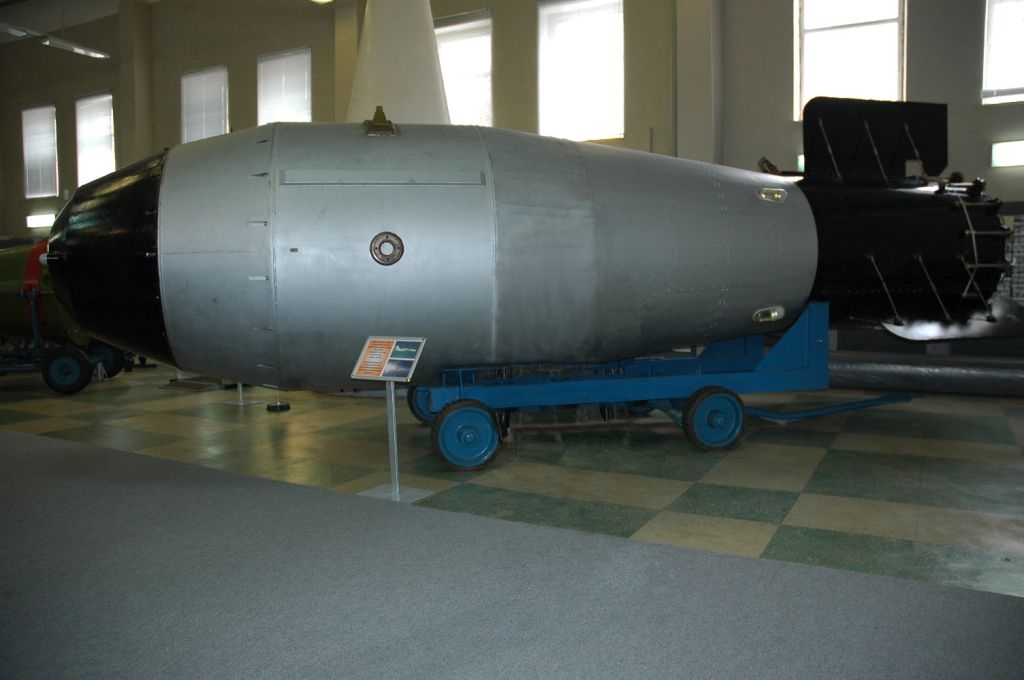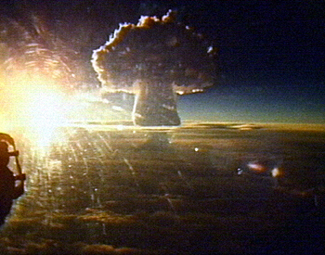In 1954, just nine years after the first atomic bomb was detonated, the USSR began researching a "superbomb," capable of more than four times the explosive yield of the largest weapon detonated by the United States. The bomb, which found its roots in the Cold War, was developed from 1954 to 1961. This was an extraordinarily massive project, combining the issues of material sourcing and bomber carrying capacity with the more abstract ones of political fallout, the "bomber gap," and the tensions of the Cold War.
 |
| Tsar Bomba casing |
In 1961, the Tsar Bomba was completed. It was a three-stage bomb, which is in effect three bombs, the first one a fission bomb that compresses the second, which in turn compresses the third to release an enormous amount of energy. It is hypothesized that the Tsar Bomba actually had multiple third stages, resulting in a vastly increased yield.
The Tsar Bomb had the potential of a 100-megaton yield, which would have been about seven times greater than the Castle Bravo test and about 6,700 times the "Little Boy" test. The actual yield was adjusted by the directors of the program shortly before it was tested, since they felt it would be more effective if the pilots actually survived the test. The Tsar Bomba weighed in at almost 30 tons, about the weight of a T-34 tank. This made it very difficult to transport, especially when combined with its enormous size, at 26 feet long.
 |
| A Tu-95 at Engels Air Force Base |
The bomber, a Tupolev Tu-95, was modified specially for the Tsar Bomba test. Its bomb bay doors and fuselage fuel tanks were removed, meaning that it had barely enough fuel to reach the target. Since the Tsar Bomba was equipped with an enormous, 1600-square-meter parachute that weighed almost a ton, the Tu-95 would be able to escape to about 30 miles away before the bomb detonated. This gave the pilot and crew a 50% chance of survival. If it had been 100 megatons, this would have dropped to about 0%.
 |
The mushroom cloud—from 100 miles away.
At the time this was taken, the cloud was 40 miles high.
The shockwave caught up with the observer plane
just a few seconds later. |
The bomb was tested at 11:32 in the morning on Severny Island, above the Arctic Circle. The mushroom cloud reached over 59 miles in the air and could be seen from two hundred miles away. The detonation broke windows up to 560 miles away, in Norway and Finland, and had the potential to cause third-degree burns at 100 miles. The shockwave circled the earth three times, and the Tu-95 dropped a full kilometer in the air after being caught in the shockwave before recovering. Russian radio stations did not mention the test, instead calling attention to the two-thousand times smaller twenty-kiloton
Mink test conducted underground by the United States the day before.



1 comment:
This was incredibly informational and very well organized. I like how you explained the purposes of building these bombs and the affects of building it and testing it. The pictures and their descriptions were well thought out and helped enhance the clarity of your blog.
Post a Comment